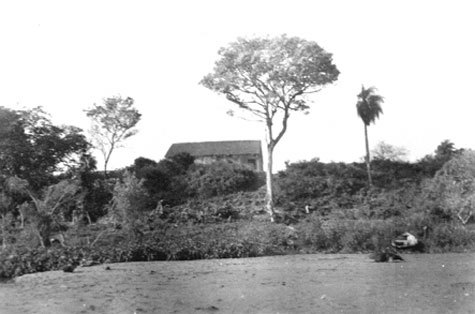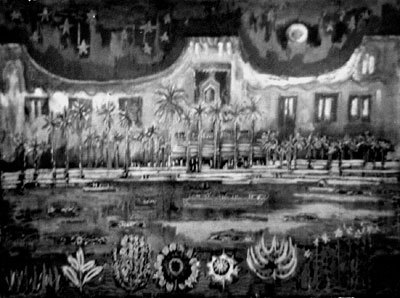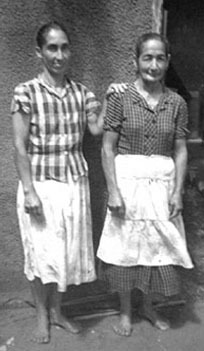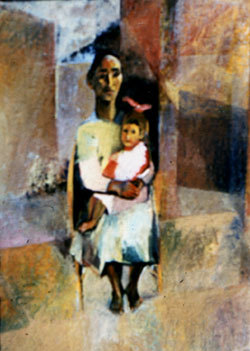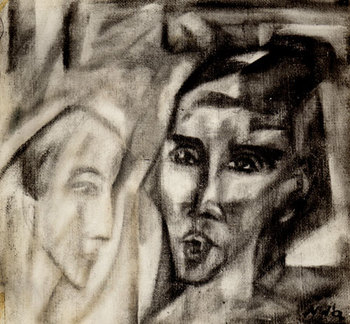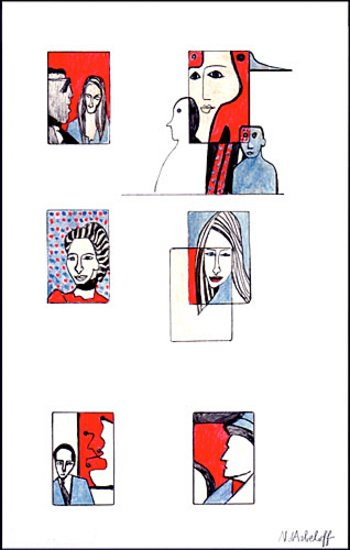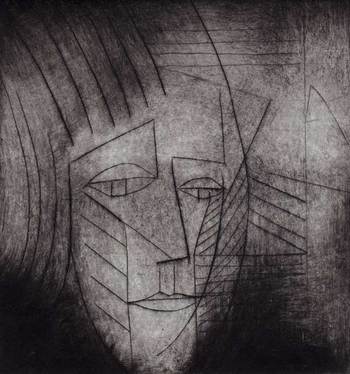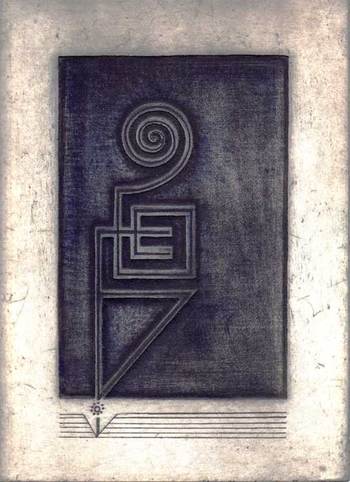Archive
My life’s fragments waiting for reassembly
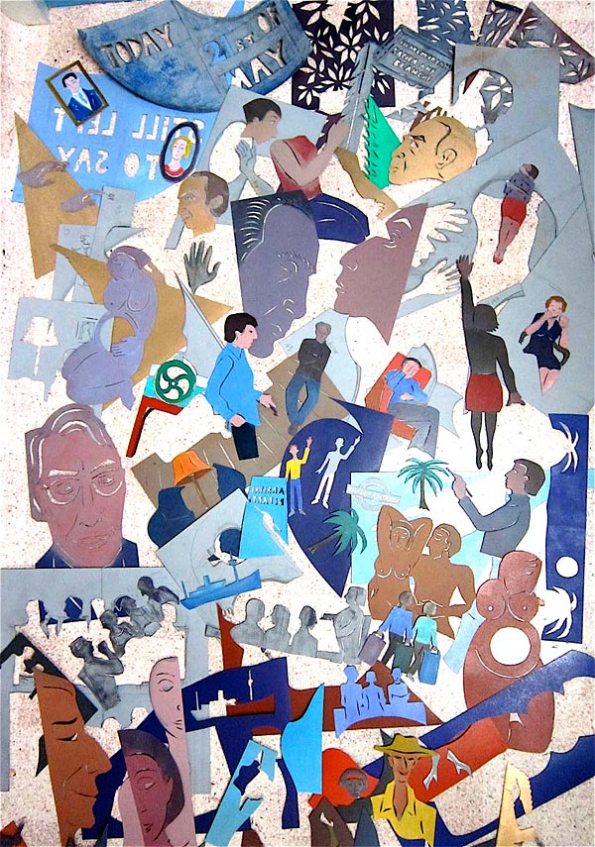
These fragments lying on the floor of my studio are some of the stencils I drew and cut to create My Life Unfolds, an accordion book included in the exhibition Open Books, which opened at the National Library of Wales on June 30 and runs until September 22. I used the stencils to make monoprints on each of the 52 folds of the accordion, representing significant episodes in my life. Although the book is finished, the multicoloured stencils remain and demand to be reassembled in new and as yet uncharted scenarios.
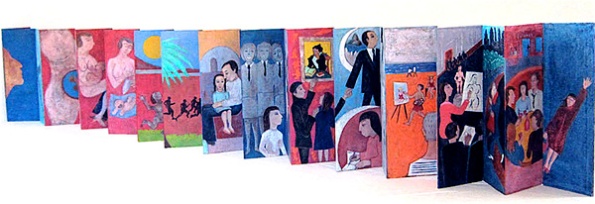
One side of the accordion book. Click to see a larger version.
The progress of the book was documented on my blog, and all the panels are shown a dedicated section of my website.
*
Born in Paris, raised in South America, USA and Europe, Natalie d’Arbeloff lives in London and has dual nationality, British-American. Her father was Russian, her mother French. Her alter ego is the cartoon character Augustine and her blog is Blaugustine where she sometimes interviews God, among other celebrities. See her website for more about her work as a painter, printmaker, book-artist and cartoonist.
Imitation Self
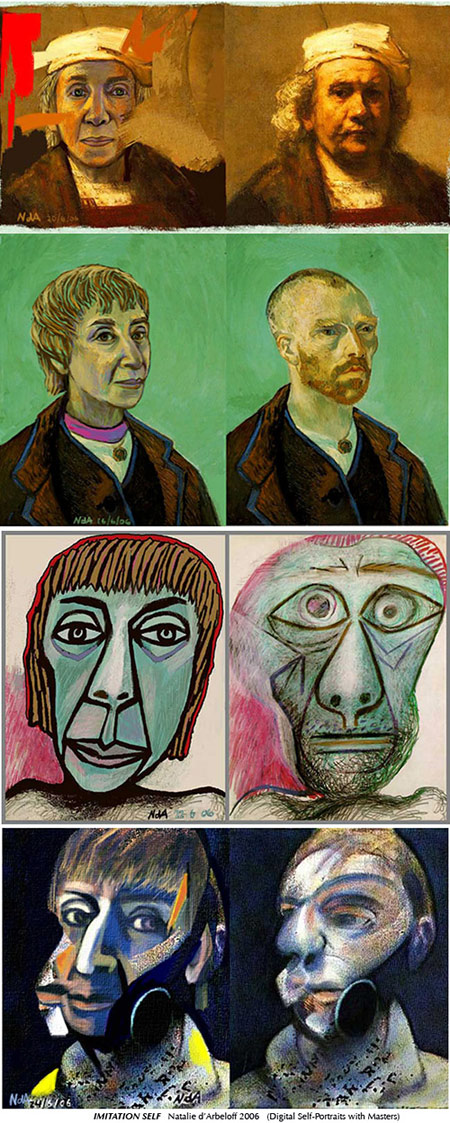
Click on image to see a larger version
Four self-portraits, more or less in the manner of four Old and New Masters I admire and envy for all the ways in which they are unlike me: Rembrandt, Van Gogh, Picasso, Bacon — all burning with single-minded dedication to their work while I flicker and flit.
Painted digitally in 2006 on my Wacom graphic tablet as part of a series posted on my blog, Blaugustine.
*
Born in Paris, raised in South America, USA and Europe, Natalie d’Arbeloff lives in London and has dual nationality, British-American. Her father was Russian, her mother French. Her alter ego is the cartoon character Augustine and her blog is Blaugustine where she sometimes interviews God, among other celebrities. See her website for more about her work as a painter, printmaker, book-artist and cartoonist.
From the Revelation of St. John the Divine
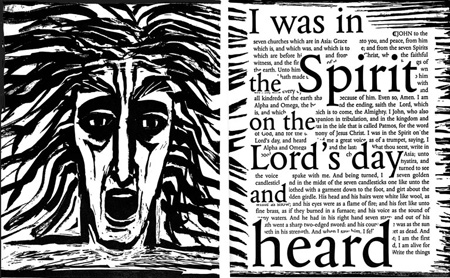
(Click on image to view at larger size.)
My friends Frances and Nicolas McDowall (the Old Stile Press) asked me to think of a book I’d like to illustrate which they could print and publish. I’d always been fascinated by the thunderous words and hallucinatory imagery of Saint John’s Apocalypse, so this is the project I suggested. They were enthusiastic about it.
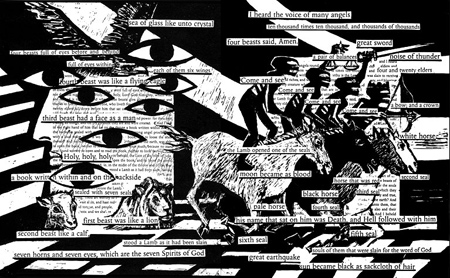
(Click on image to view at larger size.)
I decided to try and create a sense of being overwhelmed by a flood of words and images and repetitions, so I photocopied the whole text in various sizes and then made a collage of words or sentences, sometimes repeated, and drew on top of this text background in black ink and gouache. The whole of the text is there, but not always visible. Nicolas made blocks from my originals and printed them wonderfully on his hand-press. We designed a triptych binding and an edition of 150 copies was published by the Old Stile Press. Details and a slideshow of the whole book can be seen here.
Strangers in Paradise
When God and His assistant Evolutio created insects, they were drunk on a nectar they had concocted the night before, so you can imagine the hilarity. It was Evo’s idea to add all the stinging/biting/poisonous bits to the creatures, supposedly to ensure their survival, but actually because it was more fun. At the drawing board, God’s imagination went wild and the designs He came up with were just unbelievable. “They’ll never believe I did this!” He giggled.
Now I have no way of proving that this comical cosmic team was behind the farce that landed me and my ex (not ex at the time) in the jungle, but there does not seem to be a better explanation. You could say that it was because my father, a man of ideas, persuaded ex, a laid-back potter, and I, a comfort-loving city-dweller, to both become managers of a strip of land shaved out of the insect paradise in the heart of Brazil called Mato Grosso, i.e. very big forest. Mato also means crazy, so: a very big, crazy forest. The idea was that the shaved strip would eventually become a vast ranch sprinkled with income-producing cattle, golf courses for rich tourists, and model cottages with attached jobs for thousands of homeless immigrants. It was not one of my father’s more realistic ideas.
There are humans and other large animals living in Mato Grosso but the indigenous population are largely insects and they do not let you forget this for one moment. When we soft-skinned, sweet-blooded strangers arrived, armed with mosquito-repellent and sunscreen, the insects laughed so much they nearly died. But they didn’t die because insects are workaholics. No wonder they rule the earth. They are the Starbucks and McDonalds of the underworld, branches everywhere and new ones opening daily.
Our home on the bald strip of land in the middle of Mato Grosso was one of a handful of prefabricated wooden huts. Surrounding us on all four sides of the clearing was dense jungle, humming with unbridled entomological activity which, in our naive enthusiasm, we aimed to record with drawings and photographs, when we were not too busy managing our native work force: four men, one woman, two children and a baby. More personnel was due to arrive later when things were ready but since neither ‘later’, ‘things’, or ‘ready’ had been clearly defined, we were there merely as entertainment for the natives and the insects. How they applauded when it became clear that whether standing, walking, sitting or lying down, we were irresistibly attractive to legions of tiny carnivores. The smaller the creatures, the more insatiable their appetite. Not for them a sensible siesta whilst digesting one’s prey. It’s suck suck chew chew crawl crawl buzz buzz round the clock. God knows when they slept, and it’s His or that demented Evo’s fault if they don’t sleep at all. I know I am being unfair to the innocent minority, those heavenly blue, iridescently shimmering, giant Brazilian butterflies, Morpho menelaus. We could see them flickering in and out of the lush vegetation but if we tried to get closer, busy little predators made sure we had to run for cover.
Human ingenuity being what it is, we sewed netting around the broad brims of our hats, lathered every inch of our skin with the latest repellent, wore boots and long-sleeved shirts. But human ingenuity is no match for ancient insect cunning. In the heat and humidity, covered up head to toe, we sweated profusely and became caviar for the beasties. Never mind mosquitoes, tiny flies or larger creatures, such as the rhinoceros beetle which knocked down my camera when I attempted to record its slow progress on our dinner table. What really tipped the balance was the jungle chigger. These invisible instruments of torture penetrated all our defenses, invading waist, armpits, groin, ankles — anywhere they could taste our delicious sweat — and stayed there until we were driven mad by the intense itching. And then they sent for reinforcements. I didn’t know it at the time, or care, but they are the larvae of mites belonging to the family Trombiculidae.
They pierce the skin and inject into the host a salivary secretion containing powerful, digestive enzymes that break down skin cells, which are then ingested, after the tissues have become liquefied and sucked up. Also, this digestive fluid causes surrounding tissues to harden, forming a straw-like feeding tube of hardened flesh (stylostome) from which further, partially-digested skin cells may be sucked out.
It was them or us and it was obvious that they were the fittest. We managed to endure a few months of sleepless torment, frantically scratching the red welts that covered our bodies, and then we gave up. Made our excuses, said our goodbyes to the unsurprised, un-bitten natives, and left.
As far as I know, the insects still rule in Mato Grosso, and God and His assistant Evolutio are still drunk on the nectar of creation.
Editors’ Note: Another version of this story appears in Part 7 of Natalie’s online illustrated memoir, The Burial of Mickey Mouse.
Cosmic Clocks
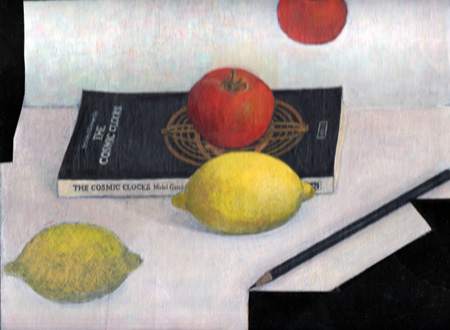
Detail of painting (oil on wood panel) by Natalie d’Arbeloff
Lost Treasure
From Blaugustine, January 17, 2006 (now included in the Autobiography archive)
The old house on the Rio Paraguay as it looked when my family first arrived there
So when and why did I decide to bury Mickey?
I’ve tried but can’t get back into the state of mind I was in when on a certain day of that happy childhood I went walking (was it by the river or in the orange grove or in the wide open flat expanse of thorny palms?) and at some point, bent down and started digging (with my fingers?), laid my beloved little Mouse in the hole and covered him with dry red soil.
Didn’t I even leave a marker on the grave, some stones or sticks? Why would I want to bury my favourite toy? All I know is that I was sure I’d find him again and when I couldn’t, some time later (how much later?) I was devastated.
And why is it that after all these years I still feel desolate about this loss? Taking the Mickey means making fun of – what does losing the Mickey mean?
When we were still living at the old stone house on the river bank, before the big house was built, we heard stories about the treasure that Madame Lynch was supposed to have buried in 1860-something, right there at that spot in the Quinta Recalde. One night when we were all asleep, there was a lot of shouting and clattering and men on horses. We were told it was the police chasing robbers who were looking for the treasure, which had never been found. Maybe Eliza Lynch did bury her stash of gold and jewels, thinking she’d come back and dig it up one day. But never did, and it’s still there. Like my Mickey.
“Mbaeveraguazu”. NdA. Gouache & watercolour.
There was a Guarani belief that Mbaeveraguazu, the legendary El Dorado or mythical golden city, was hidden in the Paraguayan jungle. Another never-found treasure. This is a painting I did as I imagined it, years later when I came back as a grown-up artist (I don’t have a colour photo. The painting is in a private collection in Italy).
I knew the words of several songs in Guarani, I still do. A young girl called Delia taught them to me; she was my friend – at least I thought so. Suddenly she’d be sullen and distant and I didn’t know why. You could never be sure that a Paraguayan would be the same from one moment to the next. Delia’s favourite phrase was “No me importa, la vida es corta, la morte segura” (I don’t care, life is short, death is certain).
That time I went back to Paraguay on my own, I painted portraits of the local people, some of whom had known me as a child and remembered my family with affection. On the right is my portrait of Annuncia holding an unknown child. On the left is Annuncia with Adela: both of them had cooked and cleaned for all of us, way back then. Below is a reflection of myself as I saw it in the glass doors of the big house, on the same terrace where I stood as a child, looking out towards the Rio Paraguay.
“Annuncia and Child” NdA. Oil on board.
“Self-portrait, San Antonio, Paraguay” NdA. Oil on board.
by Natalie d’Arbeloff
The Effect
“Head in Water”. Natalie d’Arbeloff. Oil on canvas. Collection of
Karl Genus, New York.
I was eighteen and in Paris, staying at my aunt’s place on Rue de L’Université on the Left Bank. It was what they call a “studio” but nothing like the romantic concept of north-lit scruffy splendour above the rooftops. It was a ground floor room off one of those typical Paris courtyards entered by pressing a buzzer that sets off a Pavlovian reaction from the concierge sitting in her lodge just behind the heavy pre-Revolutionary doors: her head pops up and the investigative powers of generations of concierges snap into action in her brain, confirming primeval suspicions that everyone is hiding something, even those who have grown frail pushing the same door open for twenty years. My aunt had lived in this room for about that length of time and her days flowed in slow, steady rhythm from home to work and back again. She was a civil servant in one of the Ministères in the neighbourhood. Her studio, which I had been invited to share whilst deciding what to do next, was small, dark and comfortable, nostalgically furnished with reminders of the past. The yellow satin-covered bed fitted into a mahogany surround which could by some sleight of carpentry convert from single to double divan. There were mirrors and glass bibelots and an art nouveau lamp-stand with two naked brass figures languidly leaning and lots of gilt-framed family photos, and there was an aquarium – yes, I’m almost sure of this – a goldfish tank, to separate living from cooking space. Kitchenette and bathroom were windowless nooks squeezed into the layout but somehow everything had its place and you didn’t feel cramped. Two tall, barred windows looked directly onto the street so you had to draw the curtains and close the wooden shutters at night, but you could still hear snatches of conversation as people walked by. I liked this room and had it to myself most of the time, as my aunt was at work all day, and on weekends she would usually go and visit her mother – my grandmother – outside of Paris.
The first time it happened was like this:
It might have been morning or afternoon but without a lamp on, the room was, as usual, in chiaroscuro. I sat at the dining table that doubled as a desk and closed my eyes. I decided to make a mental list of every single thing that was bothering me and then to put it aside. Quite a lot of things were bothering me but I obeyed my rule of simply naming, listing and putting aside, resisting the ever-present temptation of filling in the details, joining up the dots and jumping to invariably flawed conclusions. I began by naming my most superficial concerns – shoes too tight, hair looks awful, etc. – and moved on up the hierarchy of things, people, events or emotions which, singly or in combination, made up the state of unhappiness I was experiencing at the time. With such strict instructions to eschew embroidery and explanation, it didn’t take long to complete my list. The next step was to mentally fold it (I didn’t want to be bothered with an actual paper list) and put it somewhere out of sight. My aim was not to deny or solve the problems by this method, but merely to see what, if anything, would happen if my mind were temporarily cleared of them. The word “meditation” never occurred to me and had not yet become fashionable in the West, so my approach was strictly DIY and innocent of all Eastern influence. Surprisingly, I found it quite easy to be a blank slate once the list was out of the way. The next task I set myself was to listen intently and count every sound my ears could pick up. One by one, with the meticulous attention of a train-spotter or bird-watcher focused on the job, the smallest auditory signal was perceived and logged: individual cars’ engines, a more distant traffic hum, the clatter of heels on the pavement, voices passing by the window, some kind of boiler noise, a creaking, a rustling, a crumpling, a tooting, fragments of music from a far-away radio, my own breathing, and so on. The process was more absorbing and demanding than I could have imagined and all sense of time vanished, so I have no idea how long it was before I opened my eyes (I had kept them closed from the start of the experiment). That’s when it happened.
Everything was different. I mean literally, visibly different. I don’t know how to describe this difference without having it labeled as a “psychedelic” or “out-of-body” experience. I was absolutely in my body and in that room but it was as if someone had enhanced the focus, sharpened every outline, made it all crystalline and hyper-real. It felt both ordinary and miraculous, as if I’d been seeing the world through cataracts before but now had 20/20 vision for the first time.
Wanting to know if the Effect would continue outside the room, I went for a walk. It did continue. Every single thing became miraculous – what other word can you use when the ordinary world, without changing anything of its familiar appearance, becomes “other”? Transubstantiates? Transmutes lead into gold while still remaining lead? I vibrated with every person, every building, every object I passed. I was the strings on a violin on which the world was playing an extraordinary fugue. I walked down Rue de l’Université to the Rue du Bac and into the Boulevard Saint-Germain and sat down inside the cool, high, solemn beauty of the Eglise Saint-Germain and then I walked some more. The Effect, the amazing grace, didn’t stop but gradually became fainter as the day wore on and after that first time, I realised that it wasn’t a once-and-for-all phenomenon but would happen only after I’d gone through the ritual of list-making and sound-counting. So I began to do the ritual every day and each time it was easier and quicker.
Then other things started to happen. I would be sitting at the table in the room after doing the ritual and my mouth would open of its own accord and my throat would stretch, as if something that wasn’t me wanted to speak. I observed these things calmly, detached, like a scientist engaged in an experiment. There was no sense of panic or abnormality even if, by certain criteria, something far from normal was going on. I decided that I would try to paint while in that state and, taking advantage of my aunt’s absence during a holiday, I set up my easel, my palette and some blank canvases. I must tell you that, for me, drawing and painting anything figurative is usually a slow process and nearly always requires a model – i.e. something to look at, human or otherwise.
I sat in front of a blank canvas, oil colours laid out on the palette in their usual arrangement, brush in hand, and waited. Very soon I began to tremble as if shaken by strong winds, heart beating fast, driven by something beyond my conscious control. I began rapidly dipping the brush into paint, mixing colour combinations I never used, stabbing at the canvas with feverish speed, creating forms which appeared and disappeared before my astonished eyes in a style that was not mine and which I have never replicated. When it was finished I was exhausted, disoriented, didn’t know that hours had gone by. I’m including a photo of the first of three or four paintings I did while in this trance state.
After a while, I began to realize that the Effect and the trance, while probably related, had different sources, one positive and one negative: the Effect was good for me, the trance wasn’t. I didn’t fancy being a “channel” for some obscure occult forces, even if they wanted to use me to paint some quite interesting pictures. I didn’t like all the trembling, the heavy breathing, the sense of being possessed, drained. Magic tricks don’t appeal to me.
Perhaps, by opening a valve in my mind, clearing out the clutter and becoming completely open for a time I had allowed the miracle of the world to be revealed but simultaneously became vulnerable to invasion by less salubrious elements floating around in some other dimension. Or maybe I was just a hypersensitive eighteen year-old. Take your pick.
by Natalie d’Arbeloff of Blaugustine
Silent Movie
by Natalie d’Arbeloff of Blaugustine
